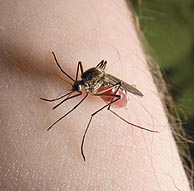
West Nile Virus
 Summertime temperatures contribute to the perfect breeding environment for mosquitoes. These insects, besides being a nuisance, can carry West Nile virus (WNV) and other diseases. Medical cases testing positive for WNV in humans were first recorded in the United States in 1999. Since that time, the number of positive cases for WNV-related diseases or symptoms has increased. Summertime temperatures contribute to the perfect breeding environment for mosquitoes. These insects, besides being a nuisance, can carry West Nile virus (WNV) and other diseases. Medical cases testing positive for WNV in humans were first recorded in the United States in 1999. Since that time, the number of positive cases for WNV-related diseases or symptoms has increased.
The following chart indicates the number of cases reported to the Center for Disease Control and Prevention (CDC), a branch of the United States Department of Health and Human Services, since the first date WNV cases have been recorded.
| Year |
Total Human Cases Reported |
Deaths |
| 1991 – 2001 |
149 |
18 |
| 2002 |
4100 |
280 |
| 2003 |
9862 |
264 |
| 2004 |
2535 |
98 |
| NOTE: As of June 14, 2005, avian or animal WNV infections have been reported to CDC from the following states: Alabama, Arizona, California, Florida, Georgia, Illinois, Indiana, Louisiana, Michigan, Minnesota, Mississippi, Missouri, New Jersey, New Mexico, New York, Tennessee, and Texas. No human cases for 2005 have been reported as of yet. |
Occupational exposure to WNV is high. The best precaution is to avoid exposure to mosquitoes when they are most actively biting. Although this may be impossible to achieve when working outdoors, the following tips will reduce the risk of exposure:
-
Apply insect repellent to exposed skin
-
Carefully follow label instructions for repellent use
-
Do not apply pump or spray repellent directly to face (pump or spray into hands to avoid contact with eyes)
-
Use repellents with lowest effective concentrations
-
The most effective repellents contain DEET (N, N-diethyl-toluamide or N, N-diethyl-3-methylbenzamide)
-
Wear long sleeve shirts and long pants
-
Handle dead animals with protective gloves (medical examination gloves recommended—not cloth or leather)
If you develop symptoms such as fever, fatigue, headache, muscle or joint pain, disorientation, tremors, muscle weakness, or paralysis, contact a health care provider immediately. Symptoms develop within three to 14 days from the infected bite. Although there is no specific treatment to counter WNV infections, and no vaccine to prevent infections, supportive care programs to treat symptoms are available.

|
|
